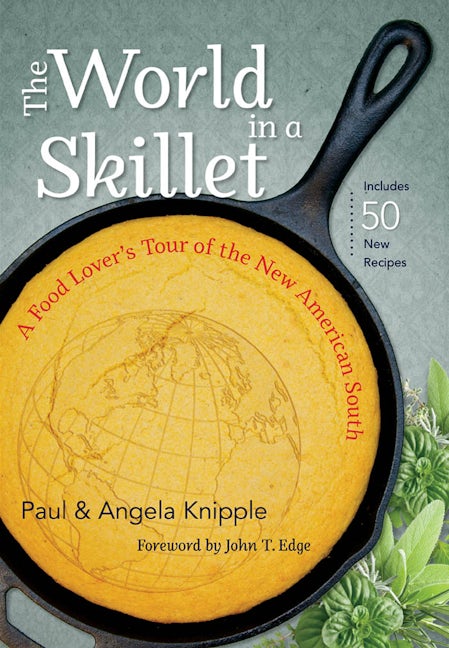The World in a Skillet
A Food Lover's Tour of the New American South
By Paul Knipple, Angela Knipple

296 pp., 7 x 10, 33 halftones, index, suggested reading list
-
Paperback ISBN: 978-1-4696-2223-1
Published: December 2014 -
E-book EPUB ISBN: 978-0-8078-6996-3
Published: December 2014 -
E-book PDF ISBN: 979-8-8908-8559-3
Published: December 2014
Buy this Book
Request exam/desk copyAuthor Q&A
Copyright (c) 2011 by the University of North Carolina Press. All rights reserved.Paul and Angela Knipple, authors of The World in a Skillet: A Food Lover's Tour of the New American South reflect on their experiences telling the story of the melding food cultures of the South.
Q: How did you get the idea for The World in a Skillet?
A: Pepe Magallanes of Las Tortugas Deli Mexicana in Germantown, TN, always asks people that he doesn't recognize if they've eaten there before. If they haven't, he tells them about his food, why quality and service matter so much to him, and why he offers only the most authentic Mexico City-style street food. We heard the story on our first visit and have heard it many times since while eating there. One day, as we were eating, we heard him ask his question, and we looked at each other and said, "We should write a book about this."
Q: Talk about your title and the idea of the skillet in the South. How does it convey your message?
A: To us the skillet represents the South in so many ways. It's enduring. It's tough. It represents family--Angela still uses her grandmother's cast iron skillet today. Although our recipes don't all require the use of a skillet, they have that same sense of enduring heritage and family.
Q: How did you decide on the book's structure and organization?
A: The people in the book decided for us. We found interesting people from different countries and areas and knew we wanted to group them together geographically. After talking to the people, though, some similarities just jumped out at us. Some excellent Central and South American restaurants might not exist without mothers and grandmothers contributing, for example. We were amazed by the strength of the Vietnamese community in New Orleans to pull back together after Katrina, but we were equally amazed that a Bosnian chef in Mobile, AL knew a Bosnian chef in Atlanta, GA. That showed us that community can reach far beyond your next door neighbor. But there were some ideas we wanted to look at from the start. Being from Memphis, the pork barbecue capital of the world, we wanted to see how Jews and Muslims dealt with the king of Southern meats. We've always been struck by what we call the "secret menu" at Chinese restaurants, as well. It's the menu that doesn't have General Tso's chicken and the pretty pictures, the one that really lets you experience Chinese food. So we wanted to find out how Chinese chefs manage to keep a balance in their restaurants. All of these were ideas we wanted to bring out in the book.
Q: What is distinctive about the South's immigrant culinary culture? coast?
A: So many of the dishes we think of as being distinctly southern food are the result of the contributions and cultures of past immigrants. The contributions of enslaved Africans are at the heart of southern food. The French influence in Louisiana also created some of our favorite southern dishes. And then there are other things like German-influenced livermush and the mystery of the Mississippi Delta hot tamale. A lot of the immigrants we talked to are very proud to be keeping their dishes true to their homeland. But the very presence of these foods in the South is expanding the definition of southern food, and just like Africans and isolated pockets of French, Germans, and Mexicans in the past, the influence of today’s immigrants will expand and be tasted for a long time to come.
Q: Q: You're a husband and wife writing team. Describe your collaboration.
A: Well, it all comes back to the skillet. Angela waves the skillet and Paul does what she says. Usually, something will strike one of us, and that person starts writing. Then we pass it back and forth making the little changes that create our unified voice.
Q: Do you have any recommendations for readers wanting to follow your path on this adventure in great eating?
A: Just go. Be open minded. Don't hesitate to tell your server what you like and let them order for you. Look around in your own community. You may be really surprised at what you find. Ask questions. If you want to try to make something you've tasted at home, most folks will be excited to share recipes with you.
Q: In this book, you argue that we are at a threshold in deciding how to preserve our coastal lands while also protecting the local infrastructure of coastal towns and villages. What threshold are you referring to?
A: This book wouldn't exist without the SFA [Southern Foodways Alliance]. We call the annual SFA symposium a foodie tent revival. For us, it brought so much into sharp focus--our love of food, our pride as southerners, and our appreciation of a good story. It was this that made us say, "This should be a book." Then it was the support of all the friends we've made through the SFA that made this book a reality.
Q: Whats next for the Knipples?
A: Right now, we're traveling all over our home state of Tennessee doing research for our next book, Farm Fresh Tennessee. We're really excited about this one because it continues the series that started with Farm Fresh North Carolina and because it's a chance to tell more great stories. Friends also got to vote on their favorites, among which are my Mini Pibil Barbecue Sandwiches and my Pimiento and Cheese Chilaquiles.
